
Perovskia, Russian sage: planting, pruning and care
Contents
Perovskia in a nutshell
- Floriferous and spectacular, Perovskia is a graceful little bush with a soft and airy silhouette
- It displays a long and generous lavender-blue summer flowering and aromatic silver-grey foliage with a spicy sage scent
- Perfectly hardy and perennial, once well-rooted in light, well-drained, poor soil, it requires no care
- It is an easy and rewarding plant, essential in a dry or non-irrigated garden, even by the seaside
- It fits in anywhere in the sun for natural scenes, in large borders and arid rockeries, as a low hedge, and even in pots
A word from our expert
The Perovskia also known as “Afghan Sage”, “Russian Sage”, “Sage of Russia” or “Siberian Sage” is a cousin of lavenders and nepeta that displays beautiful aromatic silver foliage and a fluffy azure blue flowering that lasts all summer, sometimes until the first frosts. It is one of those drought-tolerant plants that bloom tirelessly in heat-stricken gardens.
Like Perovskia atriplicifolia ‘Blue Spire‘ or the dwarf perovskia ‘Little Spear‘ which does not exceed 40 cm in height, or the very bushy hybrid Perovskia ‘Superba’, all prove to be extremely robust, resistant to everything: drought, sea spray, forgotten watering, pollution, as well as diseases.
A true drought plant, Perovskia thrives in full sun, in poor, arid, calcareous, and stony soils, by the sea as well as in urban gardens. Its rapid growth makes it an ideal plant for new gardens or busy gardeners.
Its vibrant silhouette resembling false lavender undulates in the wind in a light mass, bringing a touch of blue freshness to sunny slopes and summer flower beds.
How to take a cutting, practice pruning, or what plant associations to make with Perovskia? Discover all our tips and choose your “Russian Sage”, very trendy in recent years in all dry gardens!
Description and Botany
Botanical data
- Latin name Perovskia
- Family Lamiaceae
- Common name Russian Sage, Afghan Sage, Siberian Sage
- Flowering from July to October
- Height 0.45 to 1.50 m
- Exposure Sun
- Soil type stony, calcareous, neutral, well-drained
- Hardiness -15°C, -20°C
Issuing from the large family of Lamiaceae, Perovskia, commonly known as “Russian Sage” or “Afghan Sage”, is a small bush often regarded as a large woody perennial. Native to Central Asia and the Himalayas, this relative of sages, thymes, and lavenders grows wild in rocky areas and arid mountains.
While the genus Perovskia comprises 7 species, the most common in our gardens is Perovskia atriplicifolia and its cultivars such as ‘Blue Spire‘ or ‘Little Spear’, as well as hybrids like ‘Hybrida’ or ‘Superba’ (resulting from a cross-breeding between Perovskia abrotanoides and Perovskia atriplicifolia). The species Perovskia abrotanoides is very rarely cultivated.
In spring, flexible yet brittle stems emerge from the stump. This undershrub forms a large bushy and ramified clump with an erect habit, quite diffuse and flexible, which will reach up to 1.50 m in height when in flower, nearly as wide after three to four years of cultivation. It sometimes tends to flop over as it spreads. The growth is quite rapid, and the plant has a beautiful longevity of around twenty years.
Its aromatic deciduous silver or soft grey-green foliage, stunningly fine, undeniably contributes to its success. This lovely greyish colour will be even lighter in dry soil.
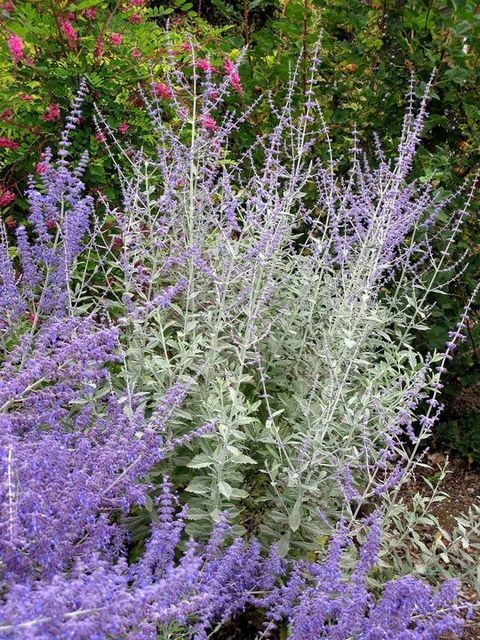
Perovskia ‘Silvery Blue’ (©Sapho)
The long stems covered with a grey-white woolly down bear small oval leaves measuring 3 to 5 cm, opposite, finely dissected and deeply divided. Similar to small fluffy feathers, they release a complex scent that is both mentholated and animal-like when crushed, reminiscent of sage or camphor.
The semi-evergreen silvery-white downy branches will remain ornamental even in winter when they are dried and stripped of their leaves.
This large light and airy silhouette subtly captures the light and sways with the slightest breath of wind, serving as a backdrop to the spectacular summer flowering.
From June to September, or even until October in a Mediterranean climate, the azure inflorescences, measuring 20 to 40 cm long, rise above the mist of the fine foliage. Countless tiny tubular and labiate flowers, encased in a narrow calyx and gathered in branched and light spikes, bloom at the tips of the silver stems. They emit a discreet fragrance. Their misty sky-blue hue, sometimes washed white on the reverse, and blue-mauve to blue-violet shades, resemble lavender.
This very abundant and particularly long flowering attracts butterflies, bees, and bumblebees throughout the summer.
The entire plant exudes a light spicy sage scent, intensified by the warm summer days.
The dry spikes, once faded, will remain decorative and enliven the flower beds during the winter months in the garden.
Hardy down to -20°C, the Perovskia can be planted in all regions. It is an undemanding plant that loves full sun and the aridity of poor, rather calcareous, stony, and gravelly soils, which are very well-drained. It withstands drought, pollution, and even sea spray without flinching.
It is a boon for dry gardens, an essential in a Mediterranean garden where it will structure a large rockery, a large perennial bed, or provide relief to the arid and inhospitable slopes of the garden as well as low hedges. Compact small varieties (‘Lacey Blue’) can also be grown at the edge or in pots to beautify sunny balconies and terraces.
Main species and varieties
The genus includes 7 species but we mainly cultivate the giant ‘Blue Spire‘ which grows up to 1.20 m tall and the smaller ‘Little Spire‘ and ‘Lacey Blue’, the two best cultivars of Perovskia atriplicifolia, the most widespread species in our gardens.
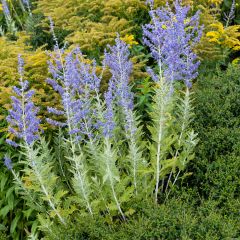
Perovskia atriplicifolia Blue Spire - Russian Sage
- Flowering time July to October
- Height at maturity 1,20 m
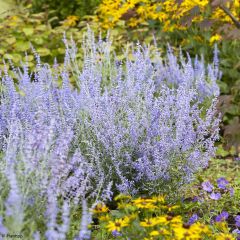
Perovskia atriplicifolia Lacey Blue - Russian Sage
- Flowering time August to October
- Height at maturity 50 cm
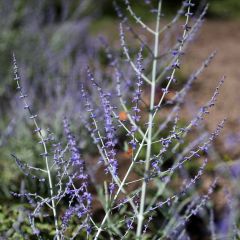
Perovskia atriplicifolia Little Spire - Russian Sage
- Flowering time July to November
- Height at maturity 80 cm
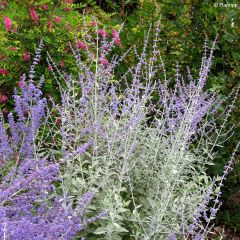
Perovskia atriplicifolia Silvery Blue - Russian Sage
- Flowering time July to November
- Height at maturity 50 cm
Discover other Perovskia
View all →Available in 4 sizes
Available in 2 sizes
Available in 4 sizes
Available in 3 sizes
Available in 2 sizes
Available in 2 sizes
Planting
Where to plant Perovskia or Siberian Sage?
From its Himalayan origins, Perovskia has retained a beautiful resistance to cold and grows everywhere in France. While the stump can easily withstand down to -15 °C to -20 °C in well-drained soil, the vegetation may start to suffer from frost from -10 °C, especially in cold and damp regions. However, the plant will regrow from the stump in spring. It may take a little time to restart properly: it sometimes waits until May to show signs of recovery. (In humid regions with harsh and rainy winters, Nepetas will advantageously replace Russian Sage.)
Perovskia fears neither drought, nor pollution, nor sea spray. A city garden or seaside garden exposed to sea spray will suit it without any worries.
Even though it tolerates semi-shade quite well, it will be more vigorous in full sun, which will enhance the silvery colour of its foliage and intensify its fragrance. It is an undemanding bush that grows naturally in poor, stony soils. It prefers dry, light, stony, even calcareous, well-drained and low-fertility soils.
Soil that is too rich would harm the plant’s silhouette, as the bush would then tend to become leggy and take on a scruffy shape.
It only fears clayey, compact, and too damp soils in winter that suffocate its roots; plant it on a sloping bank in case of water-retaining soil.
Reserve a nice sunny and well-cleared spot for it: it tends to spread, sometimes even sprawling and suffocating nearby plants. The smaller varieties have the advantage of remaining well upright, indifferent to the weather.
It is the “express” plant preferred by the impatient gardener and for new gardens! It quickly transforms a simple bed into a poetic composition, returning faithfully every year.
With its graphic yet airy silhouette, it charms gardens with a wild look. The tallest varieties are planted in the middle or back of beds, giving them a vapour-like relief and striking, moving verticality. Dwarf varieties like ‘Lacey Blue’, which do not exceed 50 cm at maturity, form compact mats in borders and are well-suited for pots on terraces in summer.
In a dry or gravel garden, Perovskia brings a welcome note of freshness. Its azure spikes integrate into all settings, on slopes, dry rockeries, sun-baked beds, or in a low hedge, bringing breath and lightness to summer scenes.
When to plant Siberian Sage
Perovskia can be planted in spring from March to May in humid climates when frosts are no longer a concern or in autumn from September to October.
How to plant Russian Sage or Perovskia
In the ground
For a beautiful effect, form a nice clump with at least 3 to 5 plants spaced 60 cm apart. You can also plant it in tight rows (every 50 to 60 cm) to create a low hedge that is light and airy.
Do not add any compost or fertiliser at planting, but a few stones or a shovelful of gravel, especially in too heavy or clayey soil to improve drainage.
- Dig a hole 2 to 3 times larger than the root ball
- Loosen the extracted soil well
- Spread a layer of gravel at the bottom of the hole
- Place the root ball in the middle of the hole, burying the collar well
- Fill the hole with the extracted soil mixed with river sand
- Lightly compact
- Water sparingly to ensure recovery
In a pot
The substrate must be very draining to avoid stagnant moisture at the roots. Improve drainage with gravel, coarse sand, or a mix of stones.
- In a large terracotta pot of at least 40 cm in diameter, spread the drainage layer
- Plant in a mix of garden soil or potting soil for Mediterranean plants and coarse river sand
- Water at planting, then without excess
- Place the Perovskia in full sun
→ Learn more about planting and growing Perovskia in pot with Virginie’s advice!
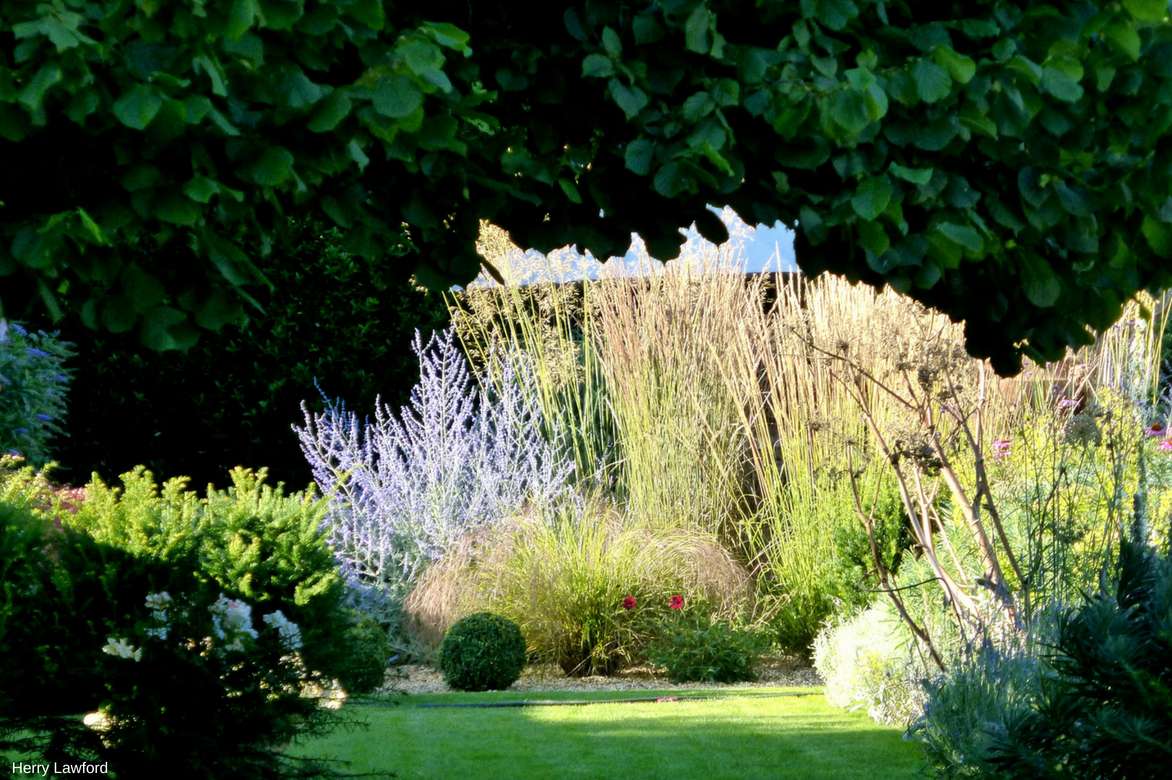
Perovskia, alongside grasses, knows how to capture light so well!
Care and pruning
Once well established, Perovskia knows how to be forgotten, going without watering and almost without maintenance. It is the ideal plant for busy gardeners and weekend gardens!
Its love for well-drained arid soils makes it wary of excessive watering: once well rooted, there is no need to water this true camel plant. No fertiliser is needed for this plant of exemplary frugality!
At the end of winter (in February-March), it is imperative to prune the perovskia down to the ground. Using shears, cut the plant to 20-30 cm above the soil to maintain a nice silhouette. Remove old branches with pruning shears if necessary to aerate the centre of the clump. If needed, wait for the new shoots to emerge, then pinch them (cut the tip with your finger) by half when they measure 30 to 40 cm in height: this will encourage the plant to ramify and densify its foliage.
This drastic pruning helps to maintain a lovely bushy shape, promotes vigorous regrowth well-furnished from the base, and ensures a beautiful flowering over the years.
In pots
Water without excess (wait for the soil to dry between waterings). In winter, stop watering. Optionally, feed it with a flowering plant fertiliser during the growing season.
Cut back the clump at the end of winter and top-dress with potting soil in spring. Repot every 3-4 years.
→ Learn more about pruning Perovskia in our tutorial.
Diseases and potential pests
In well-drained soil, Perovskia has no enemies and is resistant to diseases.
How to propagate Perovskia
The Perovskia is easily propagated by herbaceous cuttings in May or by semi-woody cuttings in August or September.
How to take herbaceous cuttings of Russian Sage?
- If you pinched the stems at the end of May, collect the cut ends during pruning
- Remove the leaves from the base
- Plant them in a well-draining substrate of soil and perlite
- Water regularly but without excess and place the cuttings in the shade
- In autumn, plant in the ground or keep the young plant in a pot sheltered until the following spring
Propagating Perovskia by semi-woody cuttings
- At the end of summer, take the tip of a non-flowering secondary stem (5 to 10 cm long), already in the process of transitioning from softwood to hardwood
- Remove the leaves from the lower third
- Plant in a porous mixture of river sand and potting soil
- Place the cuttings under a cold frame protected from frost
- Keep the substrate moist but not flooded until rooting
- Transplant your cuttings into pots
- Plant out in the following spring
- Pinch the stems to encourage bushier growth
- Water well during the first year after planting
→ Learn more with our tutorial: How to propagate Perovskia?
Associating Perovskia with the garden
Graphical and floriferous, with its white-silver foliage and azure blue flowering, Afghan sage caters to all the desires of the hurried gardener. With its tall structural silhouette, it punctuates the landscape and always serves as a breathtaking focal point in a dry garden that requires no maintenance or in a pot on a terrace.
It looks stunning in wild-looking borders and in Mediterranean gardens. It adds a vibrant and romantic touch to all blurred settings, bringing a note of freshness in the heart of summer.
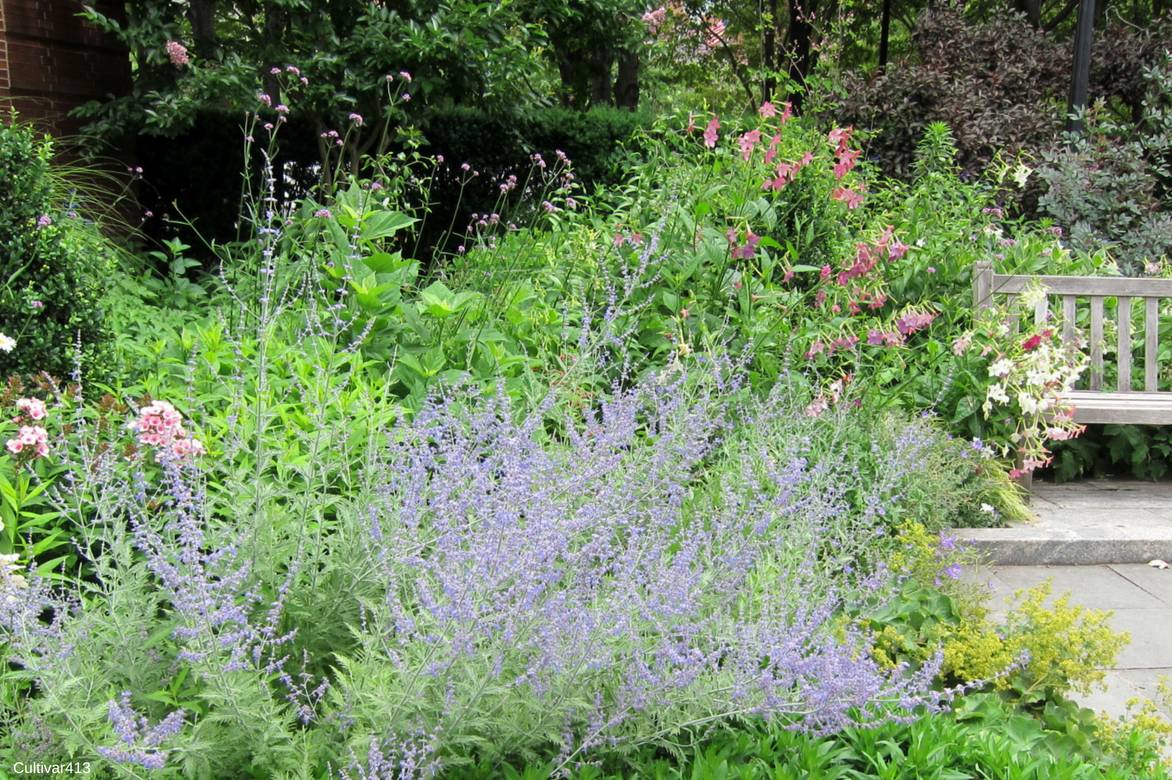
An example of pairing: Perovskia atriplicifolia, Phlox paniculata ‘Bright Eyes’, Nicotiana alata, Alchemilla mollis, Verbena bonariensis.
Easy to combine, its silver foliage softens bright and sharp colours and serves as a backdrop for many more compact perennials, adding lightness and volume.
Centrepiece of dry and wild gardens exposed to the sun or sea spray, Perovskia enjoys surrounding itself with Mediterranean plants that are equally undemanding, such as santolines, wormwoods, silver bindweed, echinops, eryngium, helianthemums, everlasting, lavenders, or creeping rosemary.
For a beautiful harmony of pastel tones, pair it with perpetual roses (which will hide their base until autumn!), a few clumps of large nepeta, gauras, and alliums with small purple heads, echinaceas, and Verbena from Buenos Aires.
In borders, it pairs well with other giant and airy perennials such as delphiniums, lavateras, hollyhocks, silver mullein, or even asters, which will provide a beautiful density to a lush composition.
It will stand out in mineral scenes, punctuated by blue-green grasses like fescues or, on the contrary, golden hues like flexuous canary grass, Stipa, golden sedge, Pennisetum, or brome, which will accompany it with the slightest breeze.
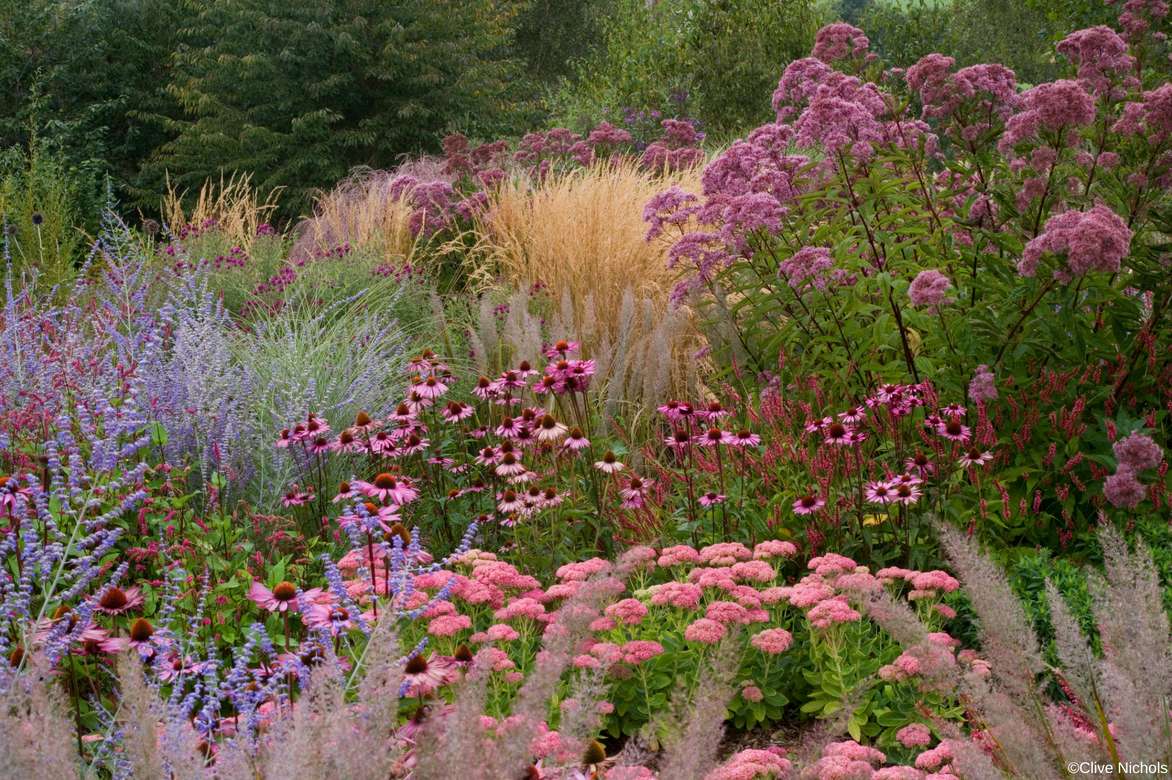
An example of natural pairing: Sedum ‘Autumn Joy’ (syn Sedum ‘Herbstfreude’), Echinacea purpurea, Eupatorium maculatum ‘Atropurpureum’, Perovskia atriplicifolia ‘Blue Spire’.
Its indigo or mauve flowers provide particularly successful contrasts with cool colours like yellow and work well with alchemillas, yarrow, wild fennel, gaillardes, rudbeckias, large-flowered potentillas, Greek St. John’s wort, or even giant fennel.
In a border in full sun, combine dwarf Perovskia with lavenders and their relatives, the sages.
On a terrace, place your Siberian sage near a solanum and a few perennials with aromatic foliage like purple fennel or a butterfly lavender.
→ Find pairing ideas with Perovskia in Gwenaëlle’s advice sheet.
Useful resources
- Do you love blue flowering bushes? Discover our article: 8 blue flowering bushes you must have in your garden
- With Perovskia, create blue and yellow summer scenes like “azure sun”!
- Advice sheet: 10 summer flowering bushes you must have in your garden
- Tutorial sheet: When and how to prune Perovskia
- Advice sheet: Growing Perovskia in pots
- Blog sheet: Perovskia ‘Blue Spire’: a must-have in dry gardens
- Subscribe!
- Contents
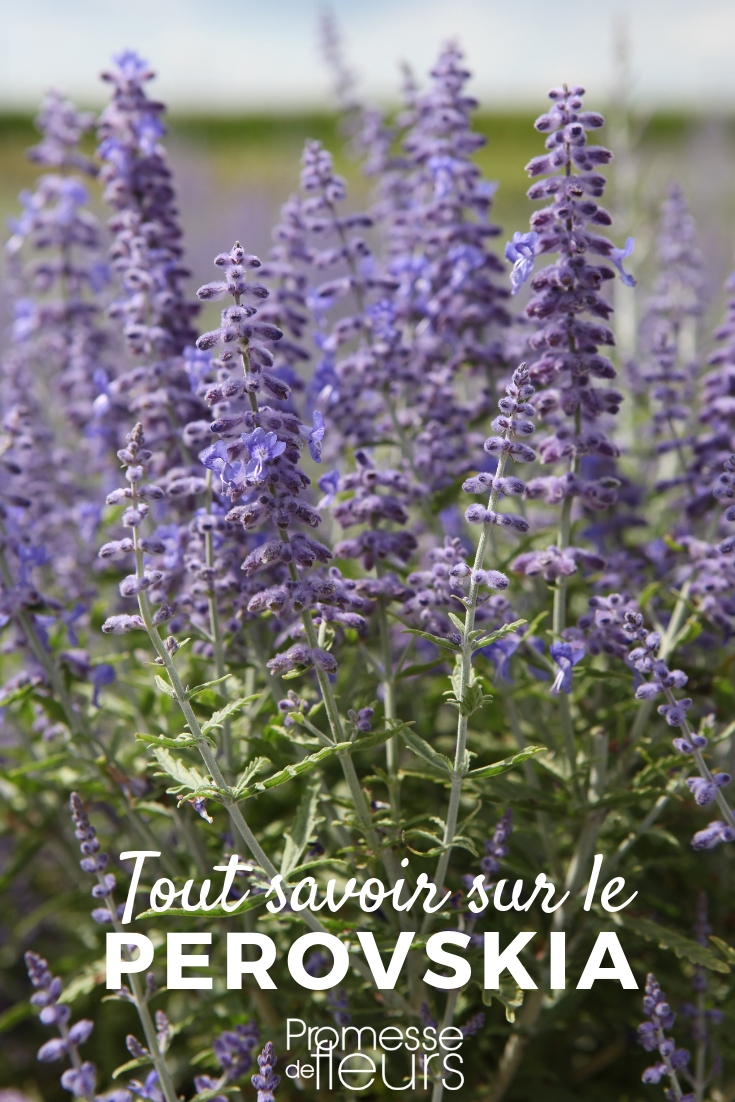






























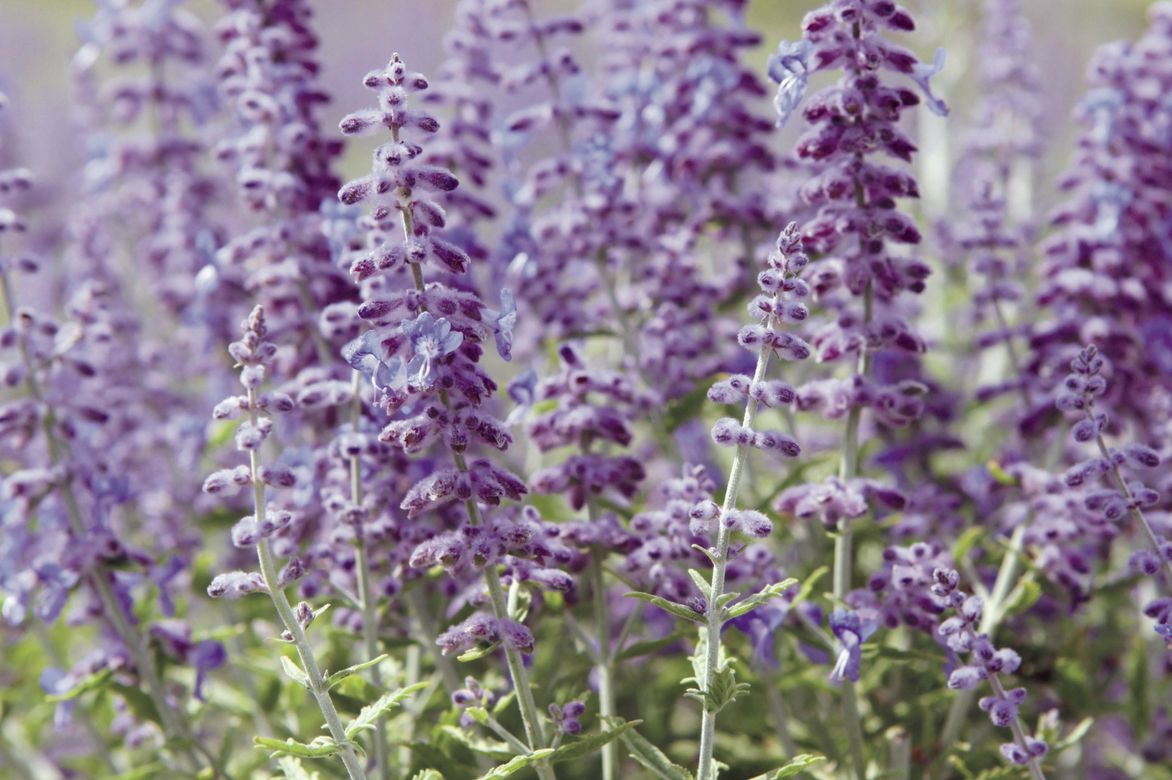

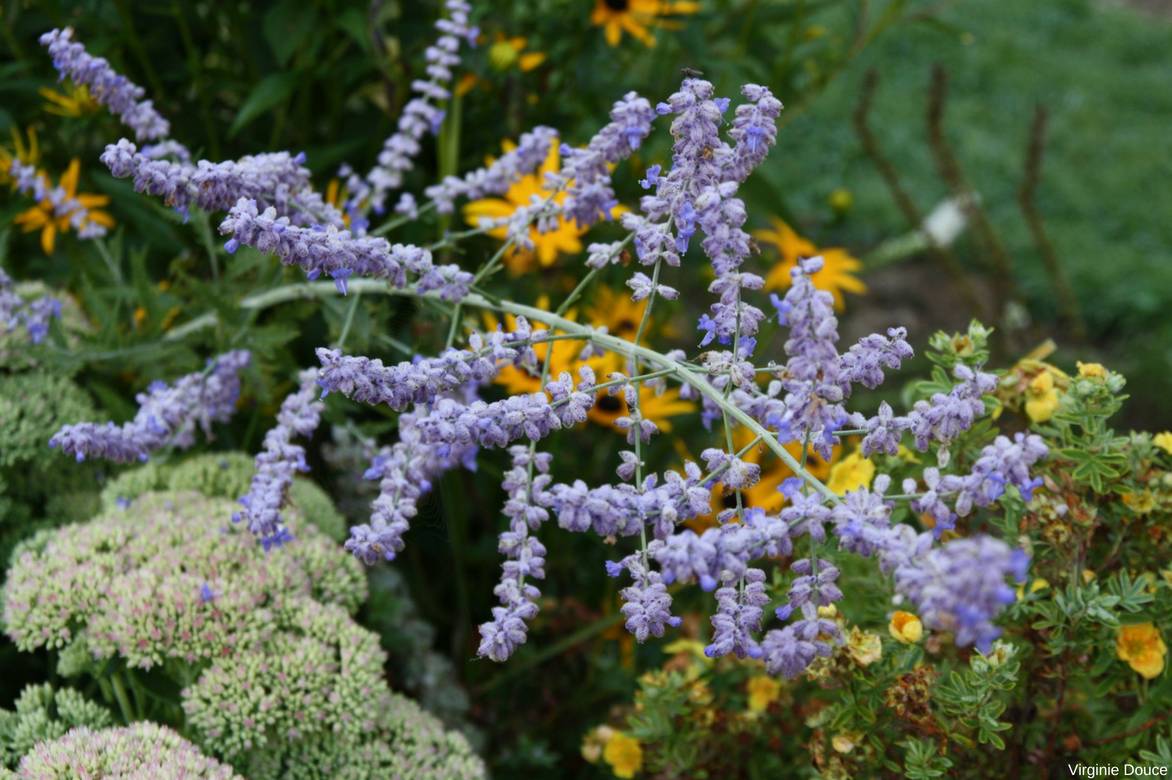



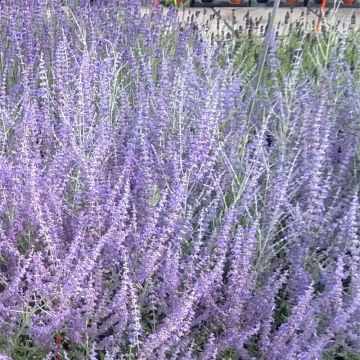

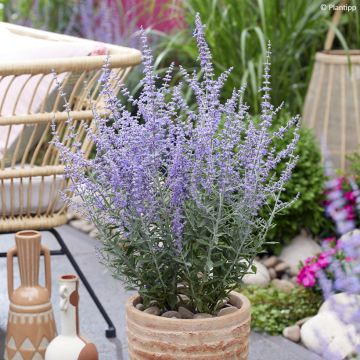
Comments